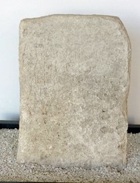
The Museo Archeologico Colfiorito is a modern museum that has a large collection of objects found in the Umbrian necropoles of the area. It also has an interesting section devoted to Roman Plestia ad the church of Santa Maria di Plestia (above). This is a link to the official site of the Museo Archeologico Colfiorito
Necropolis of Colfiorito
Some 248 tombs have been discovered since 1962 in the necropolis of that served these centres of habitation, which was located between the foot of Monte Orve and the modern cemetery of Colfiorito. As Laura Bonomi Ponzi (“L B P”, referenced below) reported, the tombs belonged to four chronological phases:
-
✴Phase 1: 37 graves (9th - 7th centuries BC) probably belonged to people from the lake-side villages (“L B P”, pp. 35-58). The grave goods found inside them (which were similar to those from the contemporary Acciaierie Necropolis, Terni) suggest a non-stratified society that buried its dead with impasto grave goods of local manufacture. (Grave goods from this phase that were found in the late 19th and early 20th centuries entered the Bellucci Collection and others are exhibited in the Sala dei Bronzi of the Museo Archeologico, Perugia.
-
✴Phase 2: 20 graves (7th and 6th centuries BC) contained more varied grave goods, including iron and bronze objects and wheel-made impasto pottery, again predominantly of local manufacture (“L B P”, pp. 59-80).
-
✴Phase 3: 125 graves (6th - 4th centuries BC) represented the community in its prime. These included a small number that contained prestige grave goods (bronze fragments of pieces of armour and from ceremonial chariots as well as items used in banqueting) indicative of an aristocracy that had forged trading links with the neighbouring regions on both sides of the Apennines (“L B P”, pp. 81-134). Maria Romana Picuti (referenced below, at p. 42) associated this phase of use with the settlement of Monte Orve discussed above.
-
✴Phase 4: The remaining 66 graves (late 4th and 3rd centuries BC) betray the influence of Rome after the conquest (“L B P”, pp. 135-8).
Phase 1
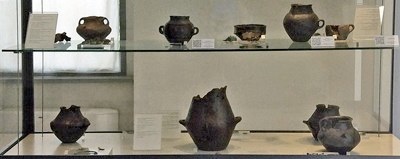
This display case contains grave good from:
-
✴on the upper level:
-
•three female tombs of the 8th century BC (tombs 146, 211 and 134); and
-
•a contemporary male tomb (194); and
-
✴on the lower level:
-
•another three female tombs of the 9th century BC (tombs 144, 201 and 207).
Phase 2
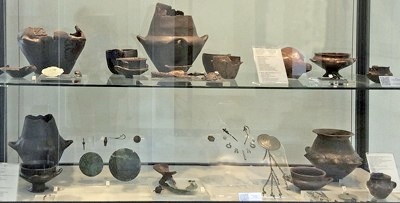
This display case contains grave good from the 7th century BC:
-
✴on the upper level:
-
•two female tombs(tombs 13 and 220); and
-
•a male tomb (tomb 174); and
-
✴on the lower level:
-
•a male tomb (tomb 206); and
-
•two female tombs (tombs 20, which includes a lovely bronze-plated disc; and tomb 145).
Phase 3
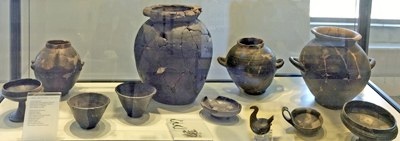
This display case exhibits grave goods from the probably female tomb 10, which dates to the 6th or early 5th century BC. They are mostly items that would have been used during banquets, and also include an impasto figure of a duck.
Phase 4

This display case exhibits grave goods from the female tomb 29, which dates to the late 4th century BC. Again, they are mostly items that would have been used during banquets.
Necropolis of Annifo di Foligno
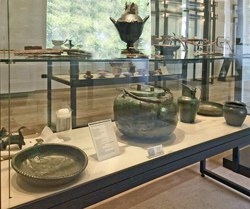
The remains of a princely tomb were found in 1984 at Annifo di Foligno, northwest of modern Colfiorito. The tomb, which dates to the middle of the 4th century BC, had already been destroyed, but it still contained part of an iron wheel from a chariot and rich tableware for banqueting. The goods were similar to those found in the warrior tombs from the 3rd phase of the Colfiorito necropolis.
The grave goods displayed here are on the upper level include the remains of the iron wheel from a chariot, a pair of fire dogs and a tall ceramic lidded vessel. Those on the lower level, which include a large cauldron, would have been used for banquets.
Sanctuary Dedicated to Cupra
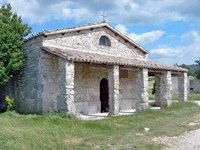
Present church of Santa Maria di Plestia, near Colfiorito
Excavations carried out in 1962-7 at località la Capannaccia, some 200 meters north of the church of Santa Maria di Plestia, (about 1 km from the museum) revealed the existence of an important Umbrian sanctuary that had been in use from the 6th to the 1st century BC.
Iron-age Village (9th - 8th centuries BC)
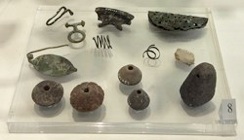
The museum exhibits these objects that were discovered in the lowest levels of the excavations at località la Capannaccia, which attest to the habitation of the site in the 9th and 8th centuries BC. This is one of three centres of habitation: the other two were located:
-
✴on the later site of the Roman city, in part under the Roman domus opposite the church of Santa Maria di Plestia (see below); and
-
✴at località Fonte Formaccia (some 500 meters from Santa Maria di Plestia, along the road to Taverne).
Votive Bronzes (6th - 4th centuries BC)

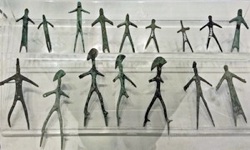
The museum exhibits a large number of votive bronzes that attest to the vibrant cult activity at the sanctuary from the 6th century BC until the Roman conquest. Other votive bronzes from this period are exhibited in the Museo Archeologico, Perugia and in the Museo Archeologico, Palazzo Trinci.
Bronze plaques (4th century BC)

cupr]as, matres pletinas sacru esu
Museo Archeologico Nazionale di Umbria (MANU), Perugia


cupr [ cupr]as, matresp[letinas
MANU, Perugia MAC, Colfiorito
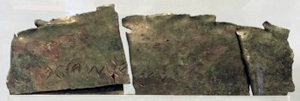
cupras, matres pletinas sacru
Museo Archeologico di Colfiorito (MAC), Colfiorito
The most important finds were four fragmentary bronze plaques with inscriptions relating to the presiding deity, Cupra:
-
✴two of which are exhibited in the Museo Archeologico, Perugia; and
-
✴two of which are in the museum here;
are inscribed in the Umbrian language using an Etruscan alphabet that shows the influence of Volsinii (Orvieto). None of the inscriptions is complete, but they can be reconstructed to read:
cupras, matres pletinas, sacru esu
I am a sacred to Cupra, mother of the Plestini
All four are illustrated on the site of the Associazione Culturale Istituto di Ricerche e Documentazione sugli Antichi Umbri, Gubbio. The inscriptions are discussed in their wider context in the page on Umbrian Inscriptions before the Roman Conquest and on Umbrian Religion.
Terracotta Reliefs from the Sanctuary (3rd - 2nd centuries BC)
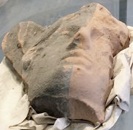
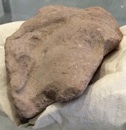

The museum displays a number of terracotta reliefs that would have decorated the exterior of the sanctuary and attest to its monumentalisation after the Roman conquest. (Other antefixes from this period are exhibited in the Museo Archeologico, Perugia and in the Museo Archeologico, Palazzo Trinci.) The notes in the museum record that they belonged to three separate phases:
-
✴antefixes from the late 3rd century BC;
-
✴decorative reliefs, some depicting chariot races, from the middle of the 2nd century BC; and
-
✴reliefs suggesting a restoration of the exterior in the early 1st century BC.
Votive Objects from the Sanctuary (3rd century BC)
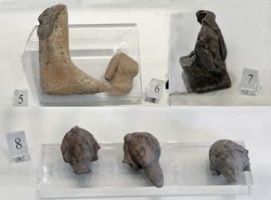
The museum displays a number of votive objects (3rd century BC) from the sanctuary, most of which are made from terracotta and depict body parts, which attest to the change in cult practices after the Roman conquest.
Coins from the Sanctuary (3rd century BC)
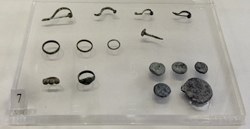
This display of objects found during the excavations of the sanctuary include coins (at the lower right) from Neapolis (Naples) and Ariminum (Rimini) that date to the 3rd century BC.
Latin Graffiti (3rd - 1st centuries BC)
The museum exhibits a number of bucchero fragments inscribed in Latin that were found during the excavation of the sanctuary, which indicate that it continued in use into the late Republic. Two of these fragments, which date to the period 225 - 150 BC, possibly record the names of a husband and wife:
-
✴P̣(ublius) Apiaie .../ us (EDR 159466); and
-
✴[A]piaiea (EDR 159512).
Plestia
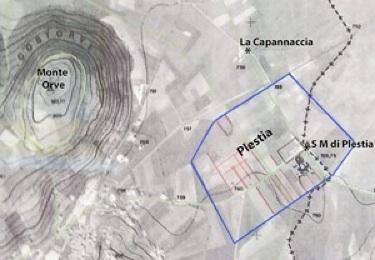
The present isolated church of Santa Maria di Plestia stands on the foundations of a public building with a colonnaded front, which was probably the “basilica forense” of Roman Plestia. The remains of its portico were discovered at the level of the church crypt. This basilica seems to have faced the forum of the Roman municipium.
Roman Domus (ca. 30 BC)
Excavations on a site opposite the church have brought to light a large domus (ca. 30 BC) with mosaic floors and frescoed walls (which was probably on the opposite side of the forum). It seems to have been restored in the late 1st or 2nd century AD, and to have remained in use until the late 4th century AD. Although it is configured as a private home with an entrance hall and other rooms around two colonnaded courtyards, its unusually large size and favoured position suggest that it more probably accommodated the municipal authorities.
Mosaics (ca 30 BC)
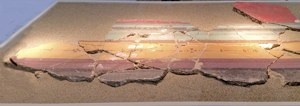

The museum exhibits a number of finds from the domus, including these fragments of decorative fresco from the walls of the two triclinia (dining rooms).
Sanctuary (ca. 30 BC)
A small rectangular room adjoining the vestibule of the domus had a portico facing the forum and contained a pit for the remains of sacrificial animals. It was perhaps used for the cult of the Lares Pubici (deities who protected the municipality). The museum suggests that the animal remains found in the pit came from 27 or 28 sacrifices made soon after the sanctuary was built and another 13 made in the imperial period.
Finds from the Pit used for Sacrifices (1st century AD)
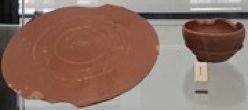

The museum exhibits a number of objects found in the pit, including:
-
✴a plate made by L. Gellius and a cup made by P. Cornelius Memor; and
-
✴two asses, one commemorating Drusus Minor (22-3 AD) and the second the Emperor Nero (64-6 AD).
Inscriptions from Plestia
The foyer of the museum contains a small number of inscriptions from the Roman municipium of Plestia (which was located about 1 km from the museum, on the present site of the church of Santa Maria di Plestia).
Magistrates of Plestia
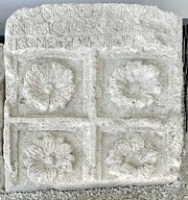
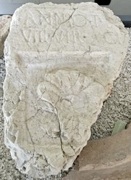
CIL XI 5621 AE 1991, 646
The most interesting of these inscriptions are the funerary inscriptions of two men who belonged to the earliest known magistracy at Plestia, that of the octoviri:
-
✴CIL XI 5621 commemorates Titus Liconius, the son of Titus Liconius Serapione and Arnila Secunda, who is recorded as:
-
T(ito) Liconio T(iti) f(ilio) Ouf(entina) VIIIvir(o)
-
Simone Sisani (referenced below, at p. 143, citing Eugen Bormann, CIL XI p. 812) dated the inscription to the early Augustan period (i.e. ca. 27 BC). This is also the earliest known reference to the tribal assignation of Plestia to the Oufentina tribe. (The EDR database -see the CIL link - gives a much later date, but I wonder if that is a mistake).
-
✴The broadly contemporary AE 1991, 646 commemorates a freedman:
-
M(arcus) Annio, T(iti) l(iberto)/ VIIIvir(o) ch...
According to Simone Sisani (referenced below, at p. 143):
-
“The two inscriptions relate to the primitive constitution of the municipality of the Plestini .... The presence ... of [this] anomalous magistracy ... constitutes a strong indication in favour of [the] early municipalisation [of Plestia]. Doubts [that have been expressed] about the nature of this magistracy fail to take into account the parallels between this case and those of:
-
-[the Sabine centres of] Trebula Mutuesca, Nursia [and] Amiternum; and
-
-Interamna Praetuttiorum [on the Adriatic];
-
where the supreme magistracy was certainly the octovirate (my translation).”
However, as Simone Sisani pointed out (at p. 271), the octovirate at Plestia was unique among the towns of Umbria. He concluded (at p. 273), on the basis of the Sabine analogues, that:
-
“... Plestia .... must have retained the status of a praefectura until the early imperial period. This hypothesis finds confirmation in the fact that the district of the Plestini was characterised by an early and persistent pattern of settlement of small nuclei scattered across the territory, which was typical of the Sabine district ...” (my translation).
According to Simone Sisani (referenced below, at p. 143):
-
“‘... the primitive constitution of the municipality of the Plestini ... only adjusted at a later date to that of the nearby municipia, with the introduction of quattuorviri “ (my translation)
This magistracy is recorded at Plestia in a now-lost funerary inscription (CIL XI 5619) that was recorded in the crypt of Santa Maria di Plestia. It had been erected by Caius Allieius Martialis to commemorate his son, Caius Allieius, who was recorded as:
[C(aio) Alli]eio C(ai) f(ilio) Ouf(entina)/ ae[d(ili?)] IIIIvir(o) quaest(ori)
The cursus here seems to be in the wrong order, but Caius Allieius had apparently held the posts of quattuorvir, aedile and quaestor. According to Simone Sisani (referenced below, at p. 273):
-
“... the first significant building [at Plestia itself] does not seem to have taken place before the early Augustan period [ca. 27 BC]. This development constituted the prerequisite for the elevation of the centre to the status of a municipium, which would have taken place concurrently with the adoption of the canonical quattuorviral constitution” (my translation).
Inscribed Tile (1st century AD)
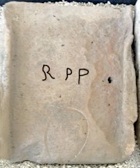
R(es) P(ublica) P(lestinorum)
(I have picked out the letters in black to make them legible). This provides evidence for a furnace for the production of tiles, owned by the municipium of Plestia.
Tarquitius Geloti (?) (1st century AD)
.../ T]ar[q]uitio Gel[oti]/ [i]nfantario posuiṭ
[P]oblicius Antioc[hus?]/ [fr]ater et Robus[ta]
It commemorates a freedman called something like “... Tarquitius Geloti”, who was an infantarius (probably an expert in the medical care of children). The inscription was erected by his brother, Poblicius Antiochus (?) and a lady called Robusta, who was probably his sister-in-law. The museum dates the inscription to the 1st century AD.
Imperial Inscriptions (late 2nd century AD)
The museum exhibits one of two fragmentary inscriptions that probably came from the vicinity of the church of Santa Maria di Plestia:
-
✴The inscription in the museum reads:
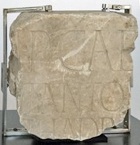
-
[I]MP(eratori) CAE(sari)
-
[di]VI ANTO[nini filio)
-
[di]VI Hadr[riani nipoti];
-
which could refer to Marcus Aurelius (161-80 AD) or Lucius Verrus (161-9 AD).
-
-
-
-
✴The second (CIL XI 5618), which was documented in the church but was subsequently lost, was inscribed:
-
[D]ivo / [Com]modo
-
and probably commemorated the deified Emperor Commodus (180-92 AD).
This reference to the deified status of Commodus has an interesting back story: the Senate declared him a public enemy (tantamount to a damnatio memoriae) after his assassination in 192 AD, but the Emperor Septimius Severus (193-211 AD) rescinded this in the following year and deified him. Septimius Severus then “adopted” Commodus’ father, Marcus Aurelius, as his own, and described himself as “divi Commodi frater” (brother of the deified Commodus). It is tempting to infer from this that the first inscription honoured the deified Marcus Aurelius (rather than Lucius Verus), and that the two dedications were made shortly after the accession of Septimius Severus in 193 AD.
Read more:
M. L. Manca, and A. Menichelli (Eds), “MAC: Museo Archeologico di Colfiorito: Guida”, (2014) Foligno
S. Sisani, “Fenomenologia della Conquista: La Romanizzazione dell' Umbria tra il IV sec. a. C. e la Guerra Sociale”, (2007) Rome
L. Bonomi Ponzi, "La Necropoli Plestina di Colfiorito di Foligno", (1997) Perugia
Return to the page on Museums of Foligno.
Return to Around Foligno.


